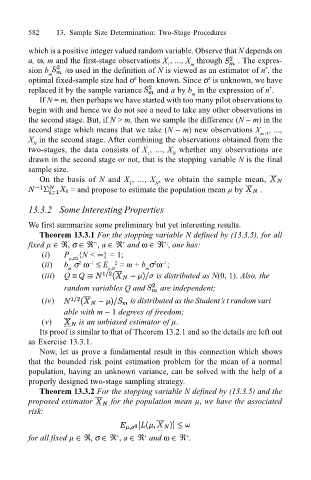Page 605 - Probability and Statistical Inference
P. 605
582 13. Sample Size Determination: Two-Stage Procedures
which is a positive integer valued random variable. Observe that N depends on
a, ω, m and the first-stage observations X , ..., X through . The expres-
m
1
*
sion b m /ω used in the definition of N is viewed as an estimator of n , the
optimal fixed-sample size had σ been known. Since σ is unknown, we have
2
2
replaced it by the sample variance and a by b in the expression of n .
*
m
If N = m, then perhaps we have started with too many pilot observations to
begin with and hence we do not see a need to take any other observations in
the second stage. But, if N > m, then we sample the difference (N − m) in the
second stage which means that we take (N − m) new observations X m+1 , ...,
X in the second stage. After combining the observations obtained from the
N
two-stages, the data consists of X , ..., X whether any observations are
N
1
drawn in the second stage or not, that is the stopping variable N is the final
sample size.
On the basis of N and X , ..., X , we obtain the sample mean,
1
N
= and propose to estimate the population mean µ by .
13.3.2 Some Interesting Properties
We first summarize some preliminary but yet interesting results.
Theorem 13.3.1 For the stopping variable N defined by (13.3.5), for all
+
+;
+;
fixed µ ∈ ℜ, σ ∈ ℜ , a ∈ ℜ and ω ∈ ℜ , one has:
(i) P µ,σ2 {N < ∞} = 1;
(ii) b σ ω ≤ E 2 = m + b σ ω ;
−1
−1
2
2
m µ,σ m
(iii) Q ≡ is distributed as N(0, 1). Also, the
random variables Q and are independent;
(iv) is distributed as the Students t random vari
able with m − 1 degrees of freedom;
(v) is an unbiased estimator of µ.
Its proof is similar to that of Theorem 13.2.1 and so the details are left out
as Exercise 13.3.1.
Now, let us prove a fundamental result in this connection which shows
that the bounded risk point estimation problem for the mean of a normal
population, having an unknown variance, can be solved with the help of a
properly designed two-stage sampling strategy.
Theorem 13.3.2 For the stopping variable N defined by (13.3.5) and the
proposed estimator for the population mean µ, we have the associated
risk:
for all fixed µ ∈ ℜ, σ ∈ ℜ , a ∈ ℜ and ω ∈ ℜ .
+
+
+

